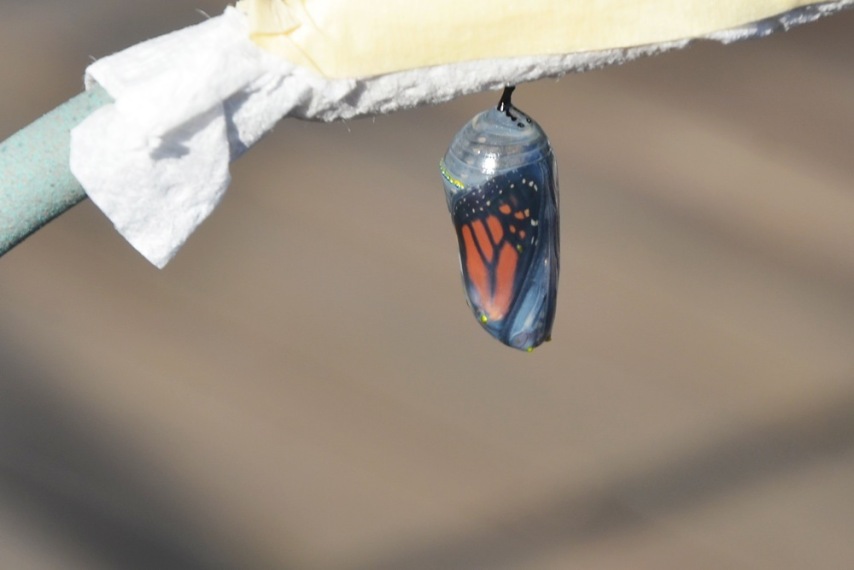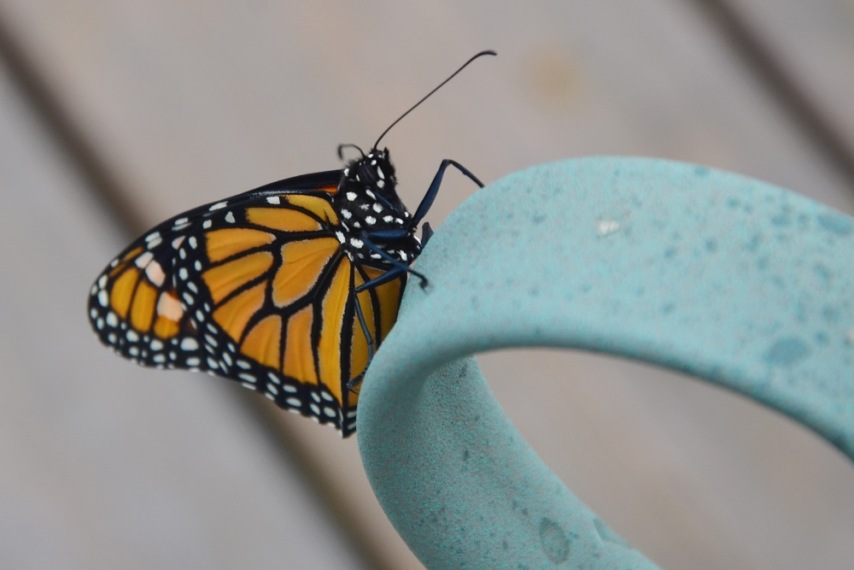I haven't updated on the caterpillars in a while. I should have at least posted when they pupated over a week ago, but since then they've just been hanging around in chrysalis form, and that's not overly exciting.
Monarch chrysalis 10 days after formation

Then this morning we came downstairs and found that one of them had finally darkened. The dark coloration is actually the monarch's wings, visible through the chrysalis. It occurs the day of or the day before eclosion, so this was an exciting find. We immediately moved him to a shady spot on our deck where we could keep an eye on him and still allow him to be free.
Monarch chrysalis, 12 days after formation, 1 hour before eclosing
When a butterfly first emerges from the chrysalis its wings are not wet, but they are folded and unusable. The butterfly must cling to the discarded shell and pump fluid from its distended abdomen into the veins of its wings to shape and strengthen them. Although it will be able to flit a few feet on wobbly wings only an hour or so after emerging, the full hardening process can take up to six hours before it will be able to fly for any real distance.



And...it's a boy! Male monarch's have two raised, black dots on their hind wings that females do not have. These dots contain the pheremones that males will use to attract females for mating.



Two hours after emerging our little guy flitted to a more sheltered location to finish strengthening. Many people who raise monarchs keep them inside enclosures during this vulnerable time and release them only after they are fully capable of flying.
We didn't have a very large enclosure, and I figured we could keep this guy safe long enough outside, but I didn't count on the thunderstorm that swept through our area just twenty minutes after this photo was taken. Some quick and inventive thinking and we had him safely back inside for the duration of the storm. Three hours later, five hours after eclosion, the sun was back out and beginning to dry the world, so we returned him to the out-of-doors. Twenty minutes later we said goodbye to our first monarch.

Now the bad news. When we started this process we had eight monarch caterpillars. The one that just left is the one we were calling fatso, which makes sense because he was obviously the fastest growing and was ahead of the others. I believe that he left as a strong, healthy adult. Unfortunately, the rest of our brood has struggled. We lost two pupae to tachinid fly parasitism. Another died while forming the chrysalis, which I believe was probably due to OE.
Following the eclosing and lift-off of fatso we have four remaining chrysalises, only one of which looks truly healthy. Two are obviously malformed, and one, which formed the latest and is several days behind the others, is showing worrying signs of either OE or fly parasitism. I continually remind myself that these are natural population controls, and that there is nothing we did to intensify the selection or bring on the troubles. At this point we are merely hoping for the best, and at least we have seen fatso off into the wide, wild, blue yonder.
Added note (6/20/12)
We have now lost three of the four remaining would-be butterflies to OE, and I believe I should have said more about this silent killer. OE is short Ophryocystis elektroscirrha. It is a protozoan parasite that infects only monarchs. OE spores are left on milkweed leaves or eggs by the adults, then consumed by the larva (caterpillar). Once the spores have been eaten the protozoa are released inside the body of the caterpillar where they divide and increase their numbers. During the pupal stage (chrysalis), the protozoa reproduce, further increasing in number, and towards the end of the pupal stage they form spores for external survival on the imago, or butterfly.
Signs of OE depend on the severity of the infection. Mild infections can be difficult to detect, and it's highly possible that we unknowingly released an infected butterfly into the wild, but severe infections lead to deformations, weakness, or outright death. We lost one caterpillar that simply died while forming its chrysalis, another emerged too weak to hold itself up while inflating its wings, another emerged with wings that were no larger than quarters, and the last was unable to fully eclose. These we euthanized by placing in the freezer, and discarded in plastic bags in the garbage to avoid the spreading of spores.
And a last note, about the tachinid fly. This fly lays its eggs inside the caterpillar or egg. The caterpillar often progresses normally, but dies during the pupal stage when the fly also pupates, and exits the chrysalis as a small brown puparium. The upside to the tachinid fly is that it does not only parasitize monarchs, but many garden pests as well, such as gypsy moths and tent caterpillars.
 bird watching,
bird watching,  gardening,
gardening,  science,
science,  wildlife
wildlife 




























































